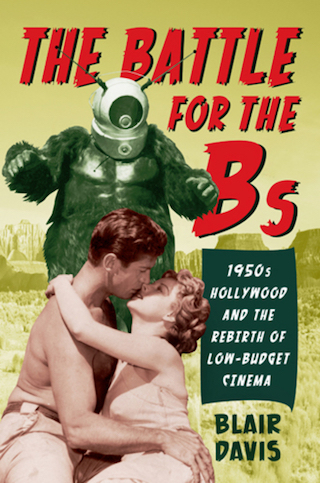 Were you a fan of ‘50s B-movies as a kid?
Were you a fan of ‘50s B-movies as a kid?The short answer is no, not necessarily, I wasn't really exposed to them. I guess that's a symptom that B-movies weren't prevalent growing up in the '80s. You'd have to stay up late to occasionally get the odd glimpse of them on TV. I can see why I was eventually attracted to them, since I was addicted to comic books, and they had a luridness, that quality of sensationalistic, bombastic imagery, occasionally done in a lower-quality scale, but that kind of hype.
How I got my first taste of B-movies was as a teenager haunting the video stores, drawn to the dark corners of the video store. The overall curiosity of when you start branching out from the mainstream, and then you start to explore the margins, and that was where I became curious about, "what were these things?’ I’d always been attracted to old monster movies: the Draculas, the Frankensteins, back to the old Universal era. You do all that, and what’s next? You start to go through the progression like the Hammer horror of the ‘50s, and the sci-fi, monster, werewolf stuff as well that was all part of it. Still, I wouldn’t have counted myself as a rabid fan; it was all kind of an academic progression.
How did this interest follow you into academia?
As my youthful obsession eventually grew into academic interests, I realized that I have always been fascinated by the margins of popular culture, so it’s little wonder that I soon found myself studying the 1950s B-movie. I began to discover that these marginalized films actually had an important connection to mainstream Hollywood filmmaking in the 1950s.
Accessibility of academic materials [on B-movies] was lacking. There’d been a lot of work done in the 1970s, and then most of it went out-of-print, so there’s sort of been an entire generation that hasn’t had access to these works. As I started doing my own research, there were other books published in that period over the last ten years, so this is a growing area of interest to many people, perhaps because it’s a new generation of scholars that has come up.
Where does the "battle" in the Battle for the Bs come in?
It was the fact that the Hollywood studios virtually abandoned the B’s and low-budget filmmaking in the 1950s as they reacted to existing changes in the industry. For instance, the move to bigger budget cinema, widescreen cinema: make less films but with bigger budgets, and there was a lot of negativity being thrown at the B’s, a lot of hostile rhetoric that we would see in articles. At the same time, people were trying to save the B’s and say, "this is a valuable product; there is room for it," and so there was sort of this turf war over the continued viability of the B-movie as a profitable entity in 1950s filmmaking. That’s where this "battle" comes in.
What do you think sets your book apart seeing the resurgence in research on the B’s?
I take B-movies seriously as an economic product, rather than just get bogged down with examinations of taste cultures. I’m less concerned with the "so bad it’s good" reaction than I am in understanding how these films functioned alongside the Hollywood film industry of the 1950s. What was their role, how did they exist, and were they in any way important or influential? So I didn’t just look down my nose at them, I pondered their viability. I chronicle how many of the auteur directors of the later ‘60s and ‘70s we’re familiar with — Coppola, Scorsese, even people like Woody Allen and David Cronenberg — got their start in either making B-films, getting their first big break and having their B-films distributed, or coming up the ranks through American International Pictures (AIP) or that type of similar studio.
I also looked at the drive-ins with the relationship to overall changing demographic patterns in the 1950s, and the move away from urban, downtown theaters to more suburban venues, in light of the Baby Boom and all of the changes of population patterns. I also look at the drive-in in relation to what was film product shortages, a result of the fact that Hollywood began making less films, with bigger budgets. And so as a result, the drive-ins are a key venue for the success of the B’s in the 1950s, because the drive-ins, many of them didn’t care what they showed. They needed a product, and they made more of their money off of the concession stand, and indeed, they found the worse the film, the more people went and got popcorn. The more films for teenage audiences — teenagers have a distincter metabolism — and so they’d go get more food, so the B’s flourished under that drive-in boom of the 1950s.
Is it fair to say that as far as cinema-going this was the first era of teens getting out and serving as a major audience?
It was the first era in which filmmakers began to recognize the potential of a teen audience, in particular with the introduction of television and more of the parents staying home and teenagers, with the rise of car culture, getting out of the house with a newfound mobility. I found that the B’s were among the first to recognize and capitalize on this, particularly in terms of making films that attempted to speak to a teen audience rather than lecture at them... Rather than having something that was trying to shove a lesson down their throats, make the exploitative genre product that audiences still crave to this day.
Hollywood didn’t know what to do with youth culture, and often didn’t want to touch youth culture, since they didn’t see the money that could be made off it. The B’s were amongst the first to do it, and to target them almost exclusively at times. For instance, AIP, not diversifying their product line, but recognizing a particular demographic, not the old Hollywood approach of making something for everyone, 8 to 80.
My book looks at the B-movie through historical contexts of 1950s Hollywood filmmaking. Along the way it looks at individual films via such issues as economic modes of production, audience demographics and patterns of distribution through exhibition. In MCS, we study cinema as a media that can and should be examined through a combination of aesthetic, historical, economic, technological and cultural approaches; my work is informed by the same belief.
I think our program has been the most welcoming program I have found for the study of marginal culture; I found DePaul’s has been the most welcoming and encouraging academic environment I’ve encountered, thus far.
The Battle for the Bs, by Blair Davis, is now available in hardcover or paperback from Rutgers University Press.
Faculty Bio
 Blair Davis received his PhD from the department of Communication Studies at McGill University in 2007, and received his MA in Communication and BA in English from Simon Fraser University.
Blair Davis received his PhD from the department of Communication Studies at McGill University in 2007, and received his MA in Communication and BA in English from Simon Fraser University.
Davis previously taught film and media studies at both Simon Fraser University and the University of New Brunswick before joining DePaul. His specific teaching and research interests include classical Hollywood cinema, B-movies, economic contexts of cinema, the intersections of film and television with other media industries, film genre studies (especially horror, film noir and science-fiction), comic books, media ecology, African American cinema, and hip-hop culture.